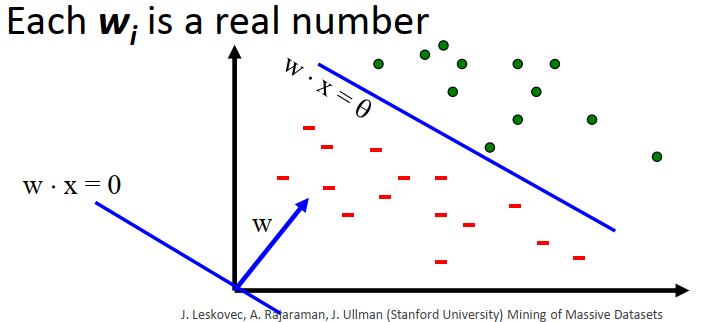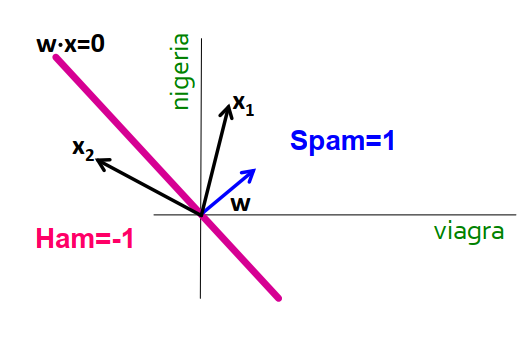Distributed machine learning with Spark
Contents
Distributed machine learning with Spark#
1. Application: Spam Filtering#
viagra |
learning |
the |
dating |
nigeria |
spam? |
|
|---|---|---|---|---|---|---|
X1 |
1 |
0 |
1 |
0 |
0 |
y1 = 1 |
X2 |
0 |
1 |
1 |
0 |
0 |
Y2 = -1 |
X3 |
0 |
0 |
0 |
0 |
1 |
y3 = 1 |
Instance spaces X1, X2, X3 belong to set X (data points)
Binary or real-valued feature vector X of word occurrences
dfeatures (words and other things, d is approximately 100,000)
Class Y
Spam = 1
Ham = -1
2. Linear models for classification#

Vector Xj contains real values
The Euclidean norm is
1.Each vector has a label yj
The goal is to find a vector W = (w1, w2, …, wd) with wj is a real number such that:
The labeled points are clearly separated by a line:

Dot is spam, minus is ham!

3. Linear classifiers#
4. Support Vector Machine#
Originally developed by Vapnik and collaborators as a linear classifier.
Could be modified to support non-linear classification by mapping into high-dimensional spaces.
Problem statement:
We want to separate
+from-using a line.Training examples:

Each example
i:


Inner product:

Which is the best linear separate defined by w?

5. Support Vector Machine: largest margin#
Distance from the separating line corresponds to the confidence of the prediction.
For example, we are more sure about the class of
AandBthan ofC.

Margin definition:


Maximizing the margin while identifying
wis good according to intuition, theory, and practice.

A math question: how do you narrate this equation?

6. Support Vector Machine: what is the margin?#
Slide from the book

Notation:
Gammais the distance from point A to the linear separator L:d(A,L) = |AH|If we select a random point M on line L, then d(A,L) is the projection of AM onto vector
w.If we assume the normalized Euclidean value of
w,|w|, is equal to one, that bring us to the result in the slide.
In other words, maximizing the margin is directly related to how
wis chosen.For the ith data point:










